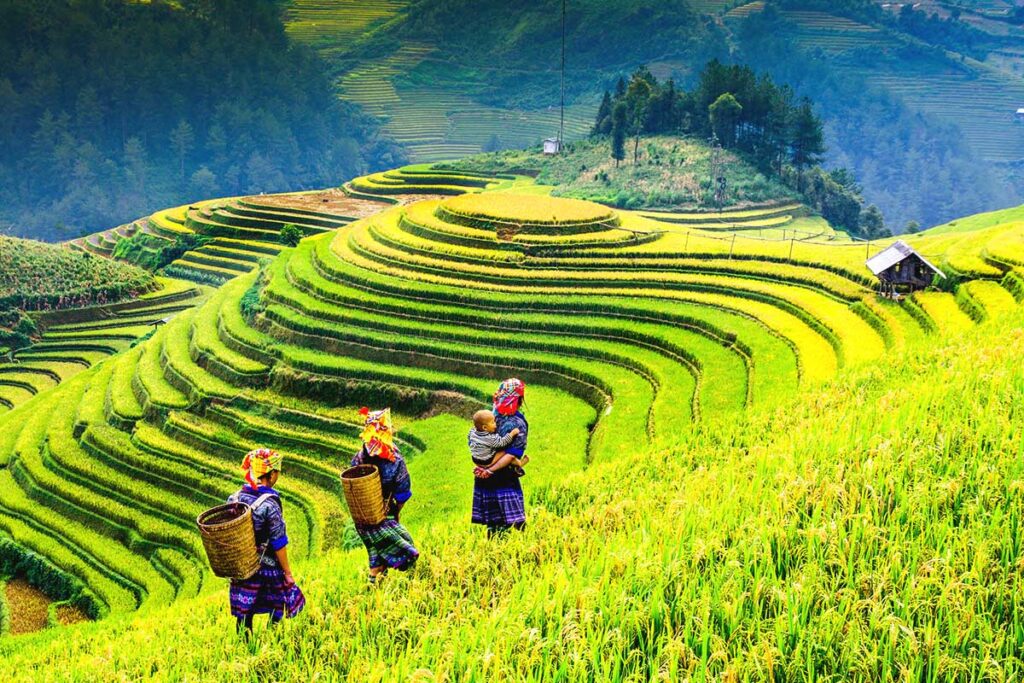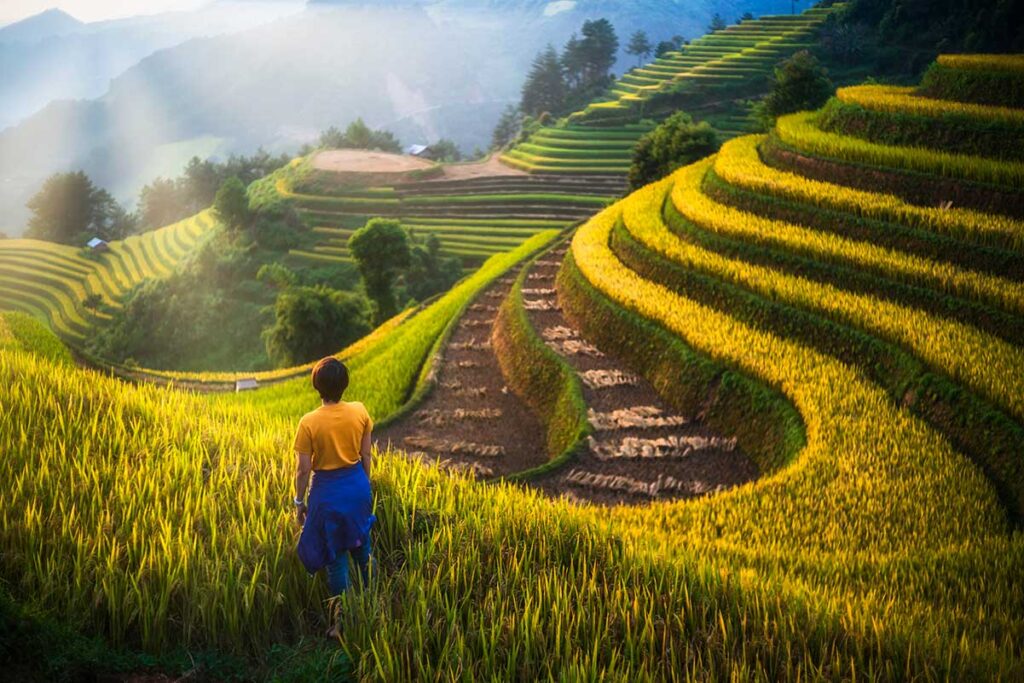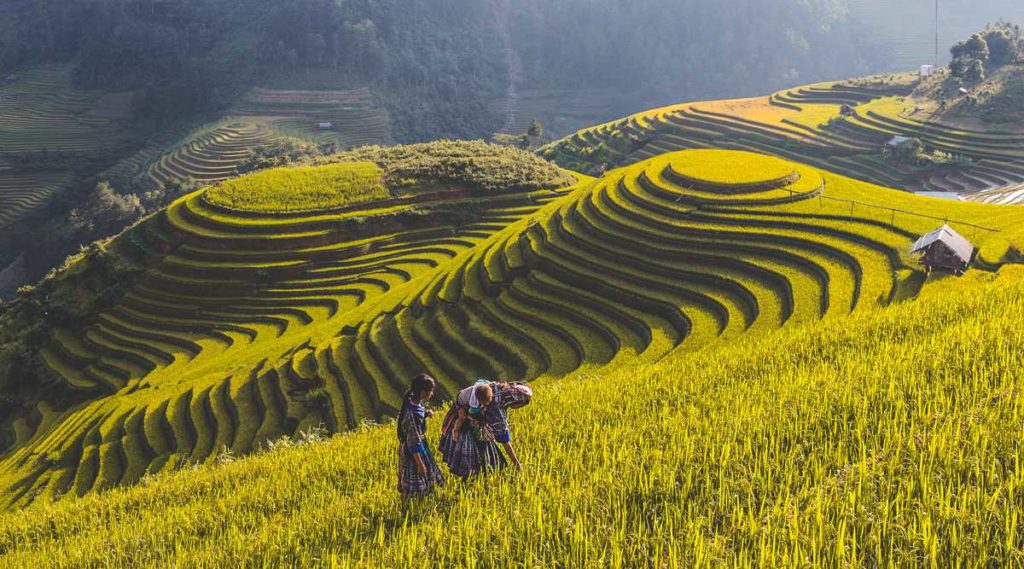About Mu Cang Chai
Mu Cang Chai is best known for its incredible rice terraces—layered fields that hug the mountain slopes in sweeping curves. These fields are not only a symbol of the region’s agricultural life, but also one of the most breathtaking landscapes in all of Vietnam, especially during the harvest season in autumn.
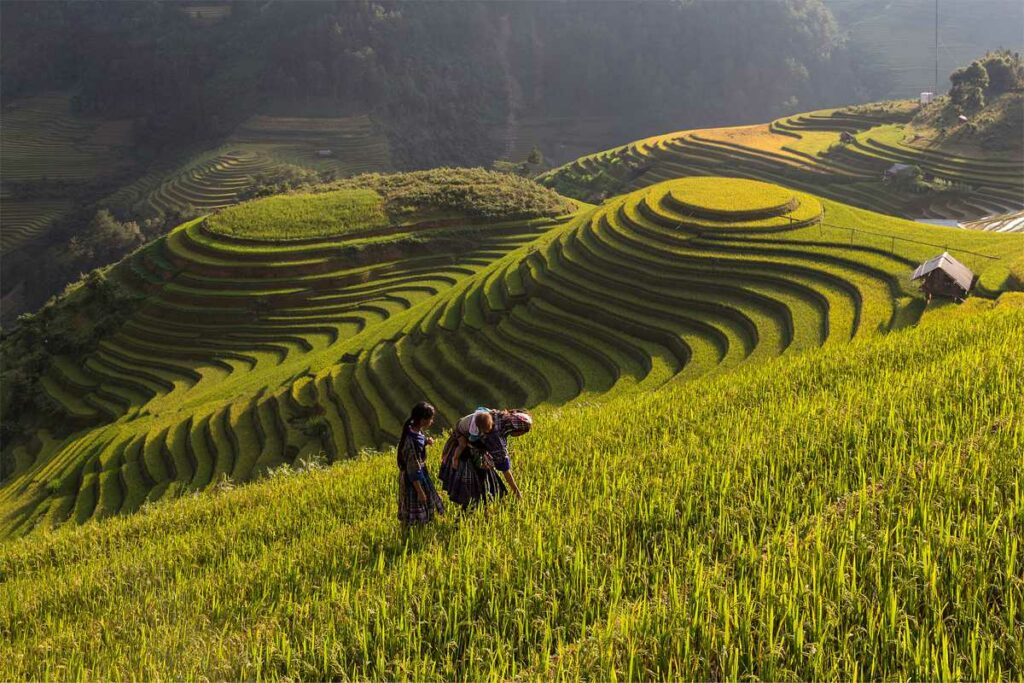
Years ago, Mu Cang Chai was referred to as “The Forgotten Land in Vietnam” because of its remote location. Now it is more famous and loved by both domestic and foreign tourists. Although more touristy than in the past, this area still remains authentic with the excellent natural landscape and traditional way of life.
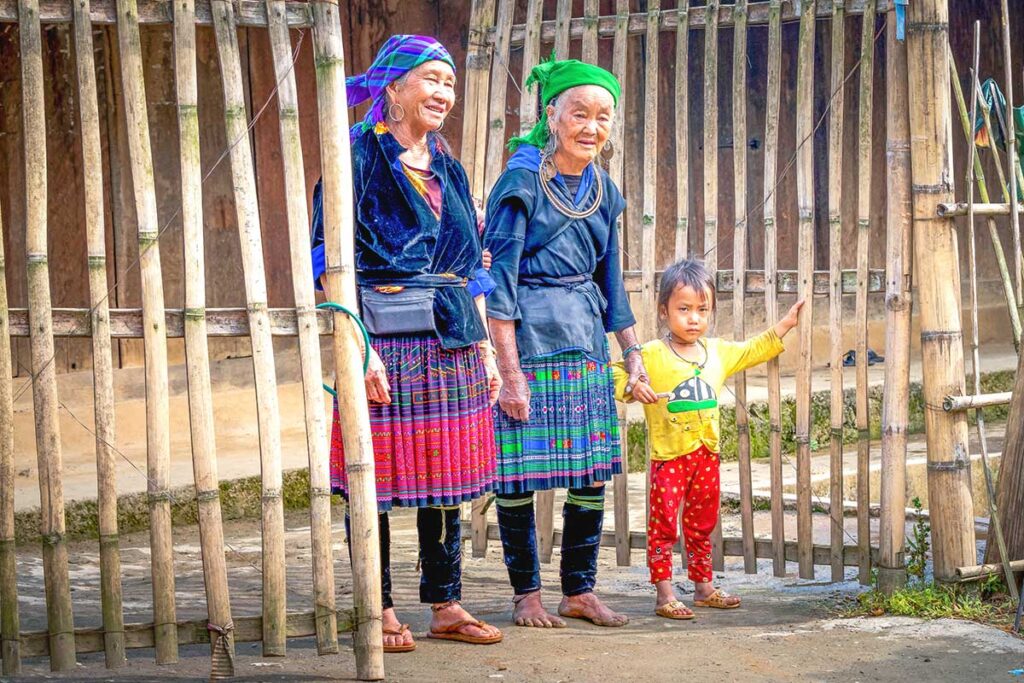
Beyond the views, Mu Cang Chai is a place to discover the everyday life and traditions of the Black Hmong, the main ethnic group living here. Their villages are scattered across the hillsides, where you can witness traditional farming, weaving, and community life that hasn’t changed much for generations.
Tip: Want to experience Mu Cang Chai the easy way?
We offer fully organized tours with transport from Hanoi, scenic stops, guided trekking, and authentic local stays:
Most beautiful rice terraces in Mu Cang Chai
Mu Cang Chai is known for having some of the most beautiful terraced rice paddies in Vietnam, or perhaps Asia itself. People have worked diligently on this artificial miracle for years. If you want to see the most impressive terraces, visit the following places and viewpoints.
1. Che Cu Nha – highest terraced rice fields
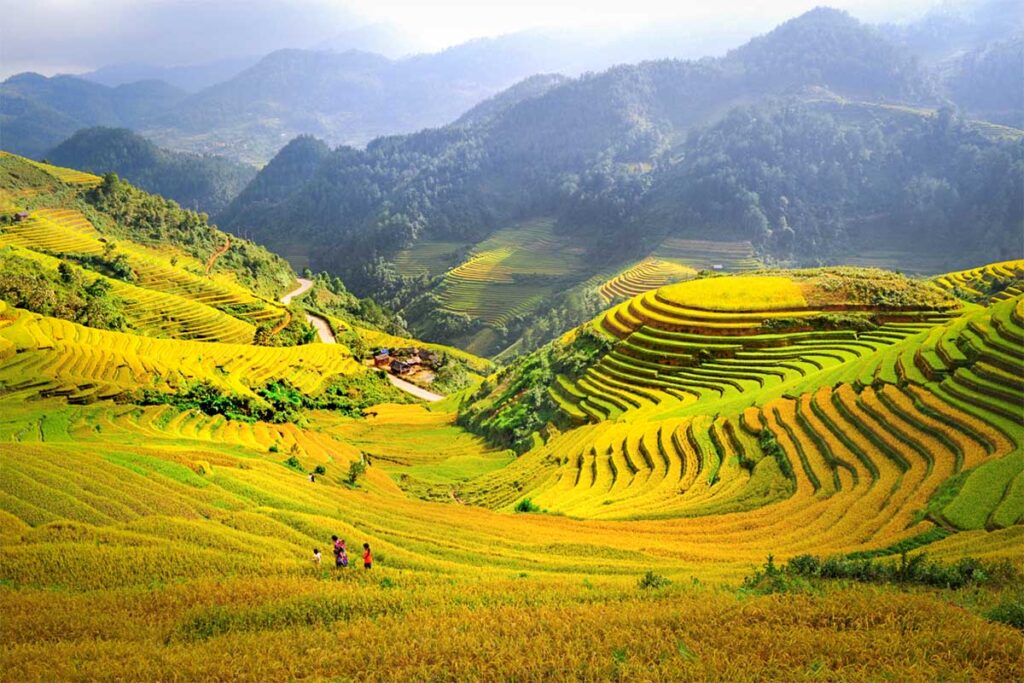
The area around Che Cu Nha has very steep slopes and a good view of the terraced rice fields. This remote commune can be found around 25 kilometers from Mu Cang Chai. The road to the viewpoint of the terraced rice fields is just 2 kilometers, but very steep and quite dangerous if you go by motorcycle. But getting to the top of the viewpoint will be completely worth it, especially on clear days. You can enjoy stunning panoramic views of the surrounding mountains that are completely covered with terraced rice fields.
2. La Pan Tan – National Heritage
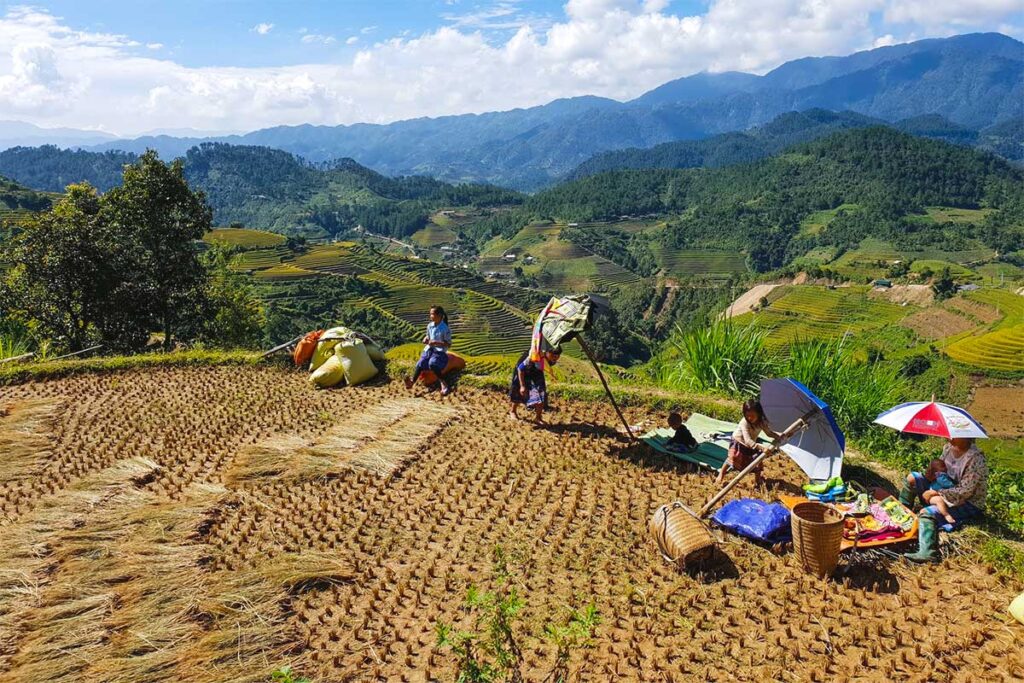
The most famous rice terraces in the area are those of La Pan Tan. These terraces are about 30 kilometers from the town of Mu Cang Chai and everyone who comes here wants to see them. That is not surprising. The rice terraces are very impressive. In addition, despite being the highlight in the region, they are not very busy yet. Certainly not when you compare that to Sapa. La Pan Tan’s terraced rice paddies have been ranked among the most beautiful in the world. In 2007, these fields, together with those in Che Cu Nha and De Xu Phinh, were labeled as national heritage. You will find here, besides the viewpoint, some small-scale accommodations and a handful of restaurants.
The road to the viewpoint is quiet steep. From the town of Nga Ba Kim, follow the road to the village. Turn right at the first T-junction to La Pan Tan Viewpoint where you can enjoy the whole panorama of golden terraced rice fields on all the mountain hills.
3. Mam Xoi Hill – most beautiful rice field hill
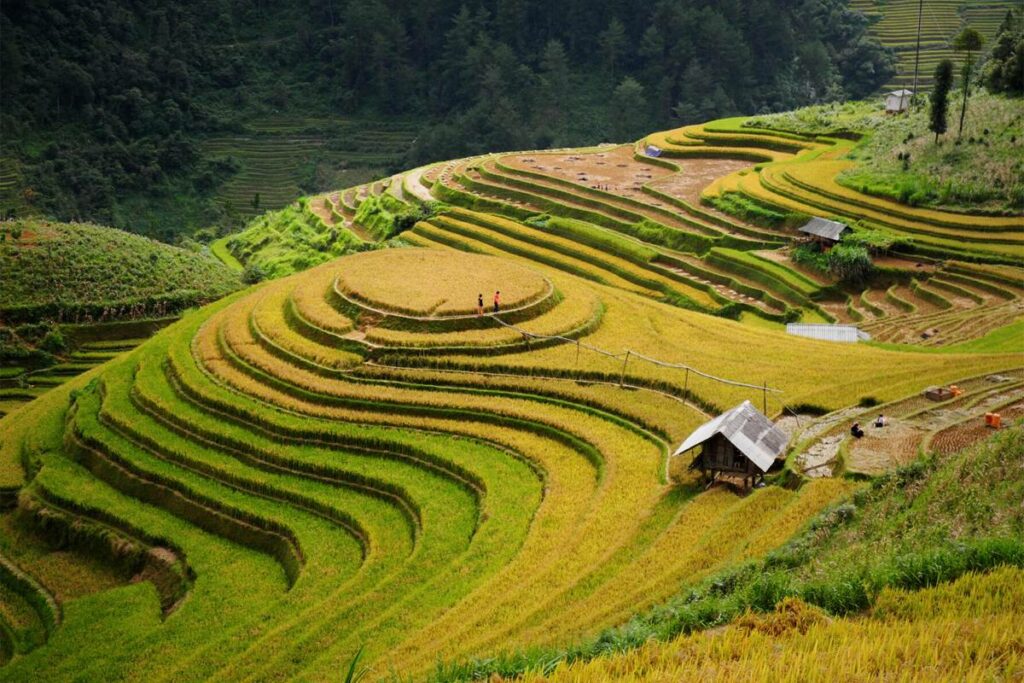
Mam Xoi, or Mam Xoi Hill (Sticky Rice Tray Hill), is located about 5 kilometres from La Pan Tan and is slightly smaller, but still very beautiful. The advantage is that this viewpoint is a bit closer to the main road. La Pan Tan is a bit further from civilization. The reason this hill is so famous is that the entire hill is made completely of terraces, so that the top of the hill has a round shape like a tray of glutinous rice.
On Ba Nha Bridge, there is often a group of locals offering travelers a guided tour to Mam Xoi Hill for around 50,000 VDN. There is also a H’mong costume rental service for those who want to dress up as H’mong people and pose with the beautiful backdrop. You can also take beautiful trekking here. Furthermore, you will find little or no accommodation or restaurants here.
4. Sang Nhu – Horseshoe hill
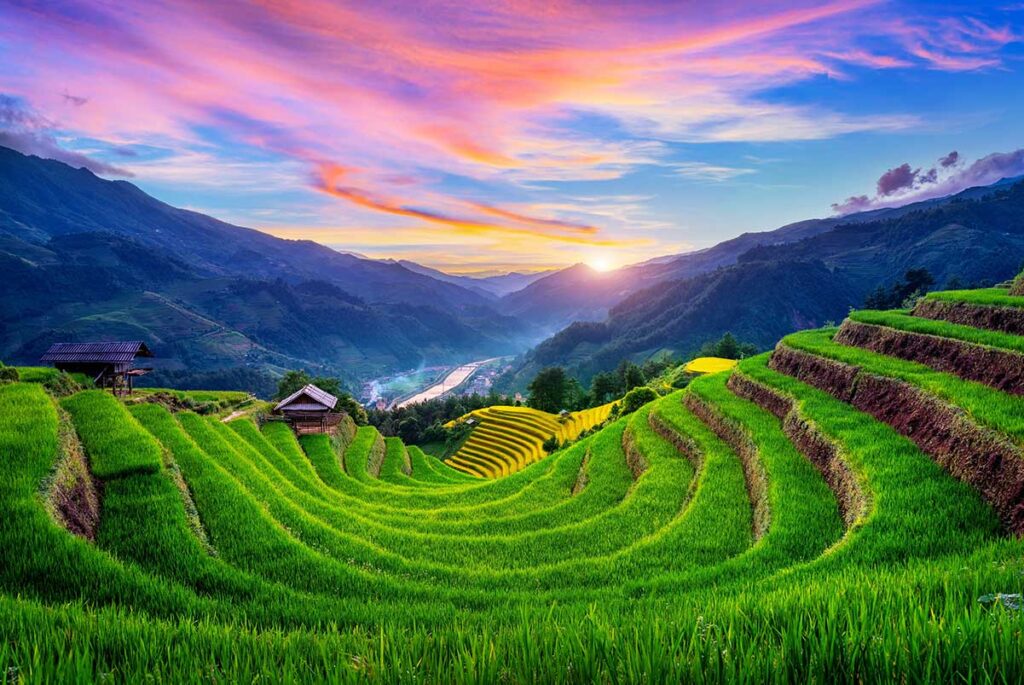
Sang Nhu Viewpoint is only 2 kilometers from Mu Cang Chai. The rice fields on Sang Nhu are mainly known by one hill called Horseshoe Hill. The terraces of the rice fields have the shape of a horseshoe.
Other sights in Mu Cang Chai
1. Villages
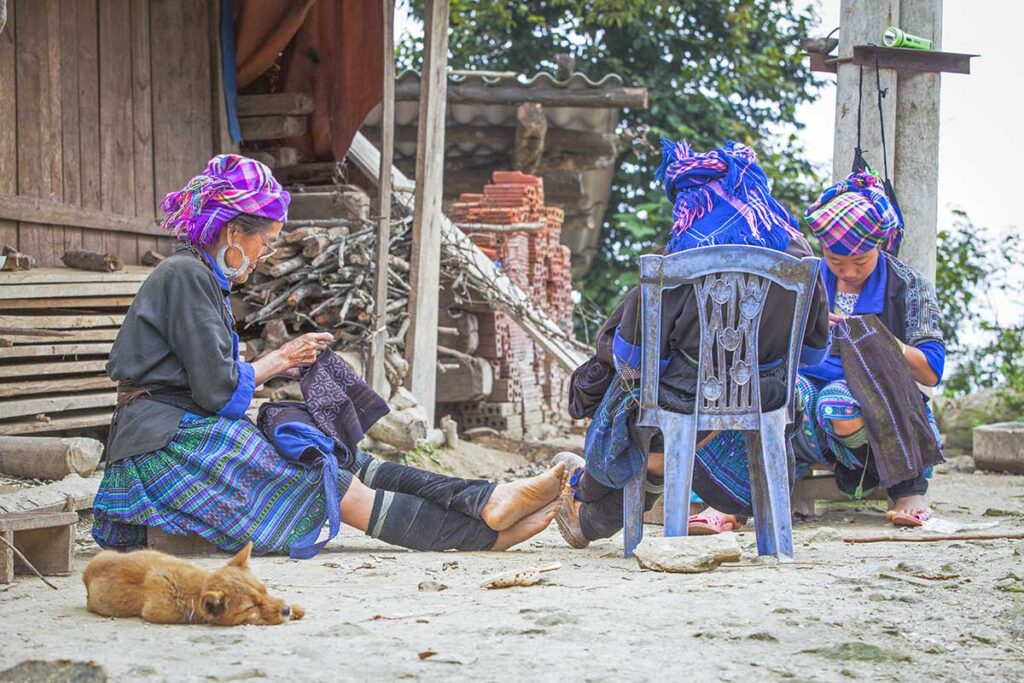
In the city of Mu Cang Chai, you have the feeling that this place is really a highland city. It is located along the river, full of shops, restaurants and food stalls. A small market in the center, with a bridge over the river leading to the village of Kim Noi Village. In this Thai village, all houses are stilt houses, made of wood. The village is also known for its homestays and the weekend’s cultural activities allow travelers to join in, such as campfire and traditional Thai dancing. Other villages worth visiting are Ze Xu Phinh, Lim Thai, Sa Ren, Lim Mong and Hua Khat. Here you will find the real traditional life of the hill tribes, especially the Hmong minority.
2. Khau Pha Pass
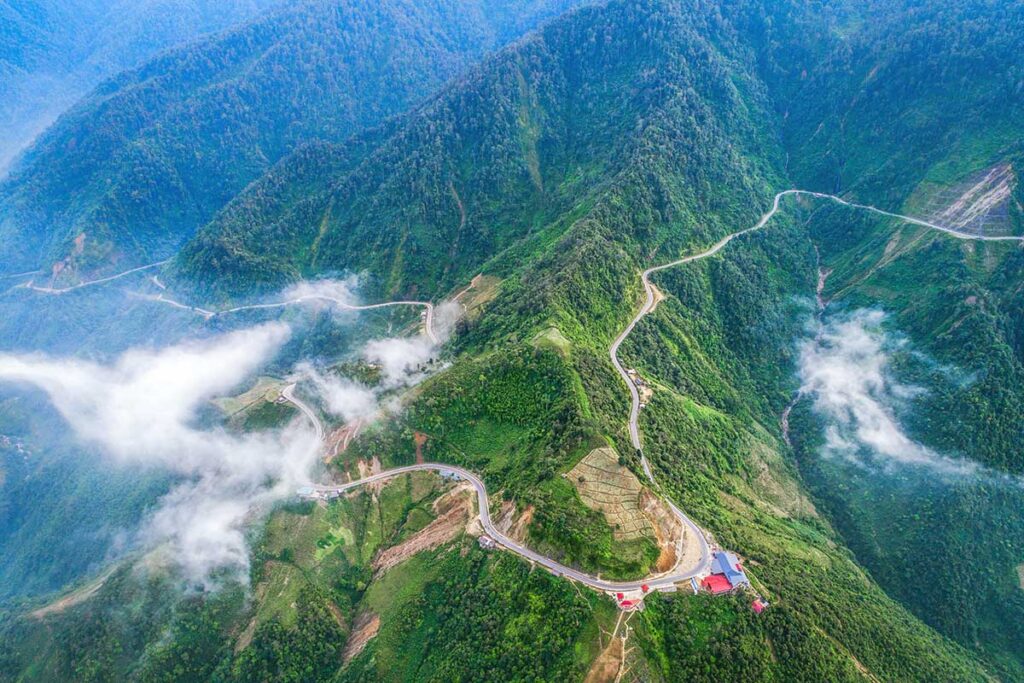
The Khau Pha Pass is one of the most stunning and dangerous mountain passes in northern Vietnam. Khau Pha is located right after the town of Tu Le and is more than 30 kilometers long. If you drive over this pass, by motorcycle or by car, you go through a very beautiful landscape. Khau Pha literally means air horn because if you are lucky you will see the top like a horn rising through the sea of clouds.
3. Waterfalls
Mo Waterfall
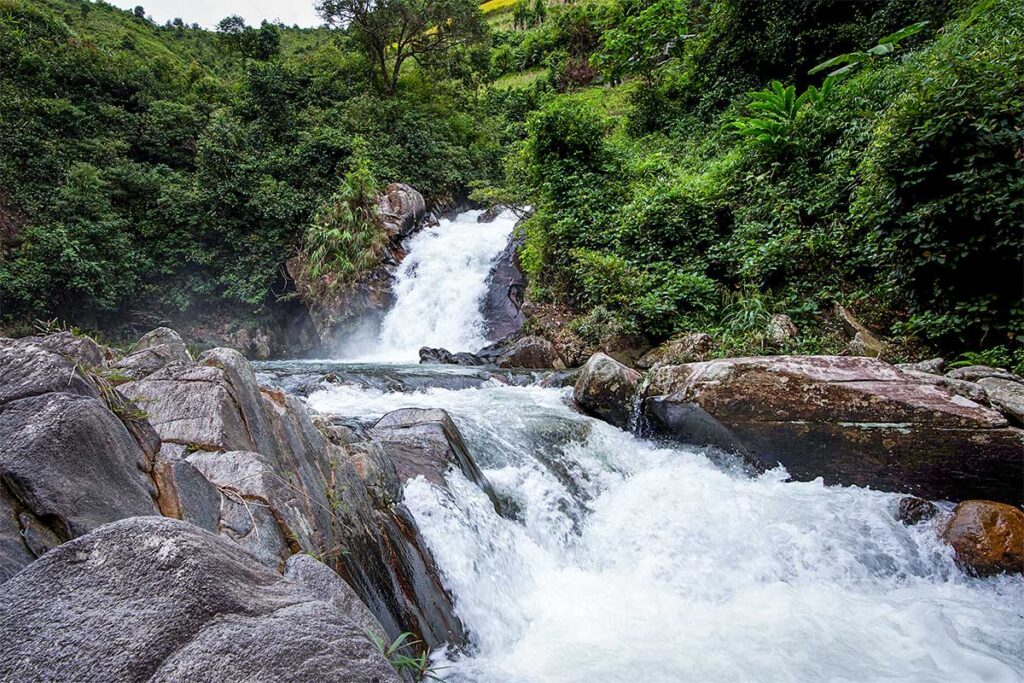
Mo (dream) waterfall is the more visited waterfall in Mu Cang Chai, located in a small canyon. To get to the base of the Mo waterfall you have to hike for around 30 minutes and if you want to see the great view from the 4th level of the waterfall you have to walk a bit further. The waterfall is most beautiful during the rainy season when there is a lot of water falling down at a height of 40 meters.
Pu Nhu waterfall
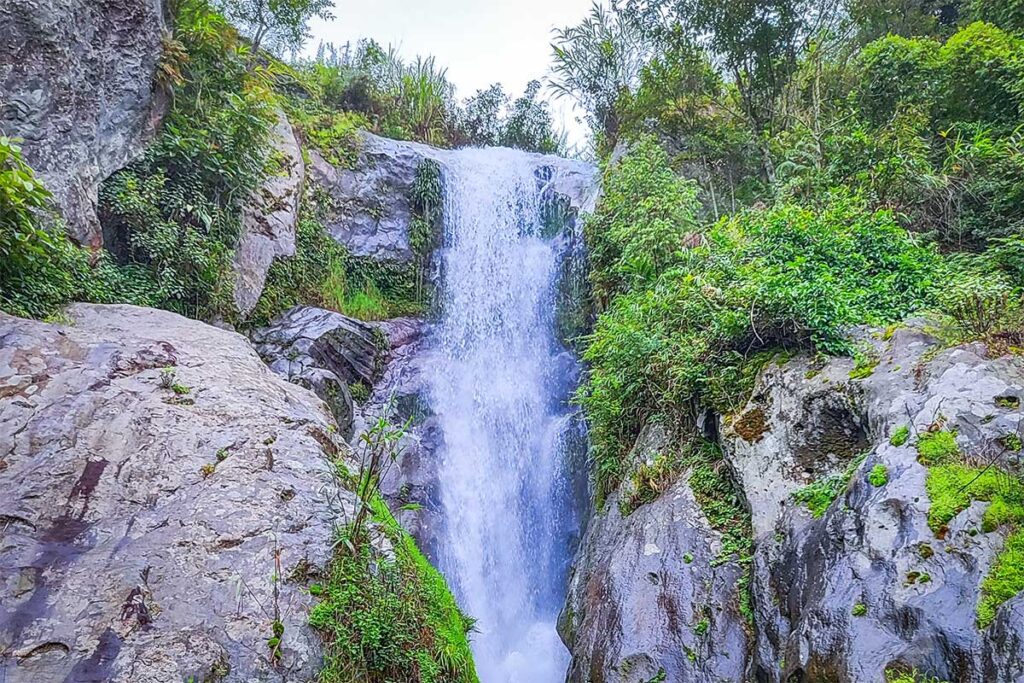
The Pu Nhu waterfall is located near the village of Pu Nhu, about 10 kilometers from the city of Mu Cang Chai. The waterfall is 20 meters high in an beautiful rocky environment.
Trekking in Mu Cang Chai
Trekking is one of the best ways to experience Mu Cang Chai. While you can see plenty from the road, walking through the terraced fields brings you much closer to the landscape, the local people, and the peaceful rhythm of life here. Unlike Sapa, the trails in Mu Cang Chai are still quiet and undeveloped—perfect if you’re looking for something more remote and authentic.
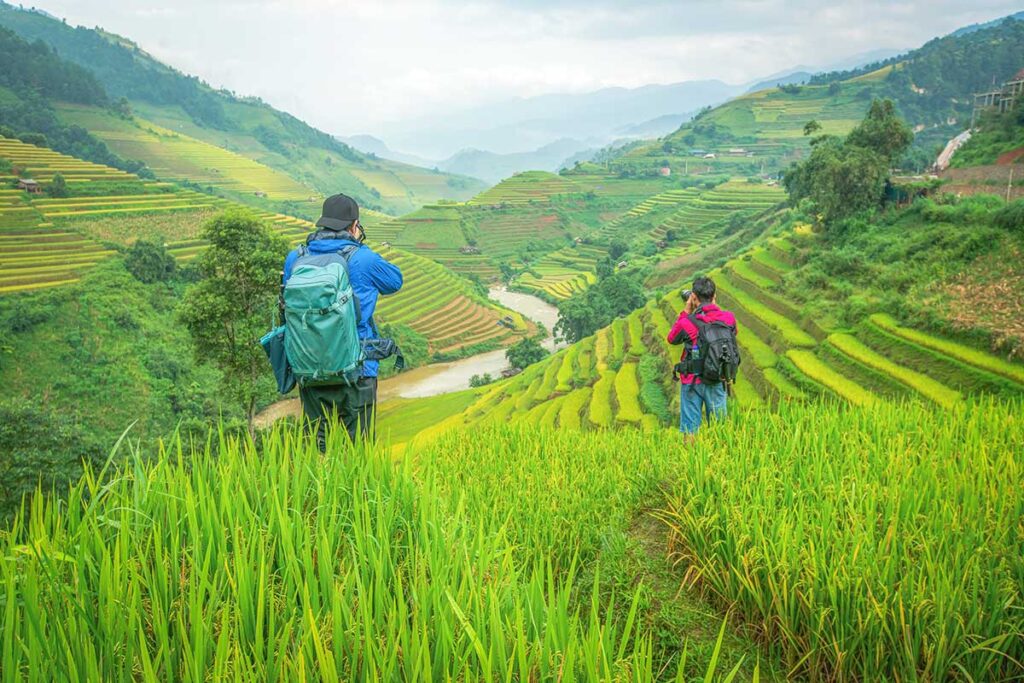
Types of treks
You can choose from short half-day walks, full-day treks, or multi-day routes that include overnight stays in local villages. A half-day trek is a good way to explore nearby rice fields and villages. A full-day or multi-day trek takes you deeper into the countryside, far beyond what you can see from the road.
Why go with a local guide
Trails are not marked, and the terrain can be confusing even for experienced hikers. A local guide doesn’t just show the way—they also explain farming techniques, local traditions, and life in the ethnic communities you pass through. It also helps ensure you’re walking on allowed paths, as some areas are private or used for farming.
Where treks usually go
Many treks start from La Pan Tan, Che Cu Nha, or Mam Xoi Hill, passing through smaller Hmong villages and ridge-line fields along the way. While there isn’t a fixed network of hiking trails, local guides create flexible routes depending on your time, interest, and fitness level.
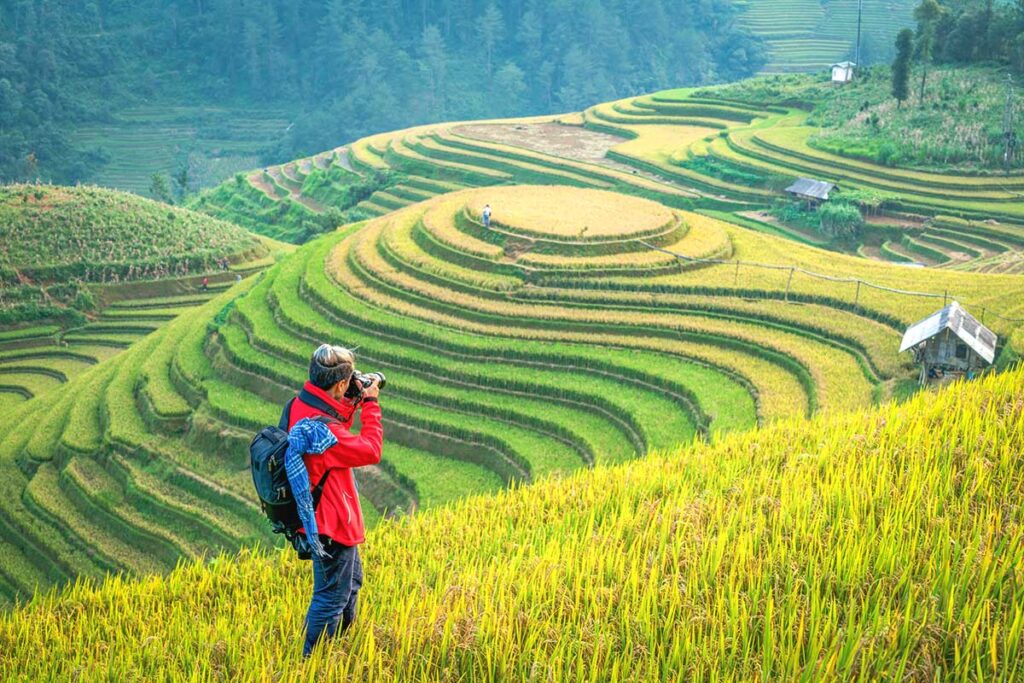
Trekking vs. Scenic driving
If you’re short on time or prefer not to walk, scenic drives along the main road offer incredible views too—especially by motorbike or with a local driver who knows the area. But trekking gives you a completely different perspective: instead of just seeing the fields from afar, you’re walking through them.
How to arrange a trek
You can arrange treks through your accommodation or a local guide, especially if you’re staying in a homestay. However, options can be limited in the low season or for longer treks. If you’d rather have everything organized in advance—including transport from Hanoi, a trusted local guide, and overnight stays—you can also book a trekking tour with us.
Explore our Mu Cang Chai trekking tours
Want everything taken care of from Hanoi to the hills? Our tours include all transfers, guided treks through the most scenic areas, and overnight stays—either in traditional homestays or more comfortable lodges.
Best time to visit Mu Cang Chai
The terraced rice fields in Mu Cang Chai don’t look like the photos year-round. Their beauty depends entirely on the rice-growing cycle, which only happens once a year. That means some months are ideal for photos and scenery—others are quieter and better for cultural experiences.
Rice growing cycle at a glance:
- Rice season per year: 1
- Planting starts: Late April to early May (watering season / mirror effects)
- Harvest time: Mid-September to early October
- Between planting and harvest: Fields go from flooded, to green, to golden
Month-by-Month Overview
January
One of the coldest months of the year, often with foggy mornings and chilly temperatures. The rice fields are bare and dry after harvest, but it’s part of the dry season, so skies are often clear. A quiet time for cultural exploration—dress warm and enjoy the peaceful villages.
February
Still cold, with fog and low humidity. The rice fields remain empty, but this is a calm month to experience everyday life in Hmong and Thai villages without any tourist crowds.
March
Temperatures begin to rise, and there are more clear days. Fields are still unplanted, but it’s a pleasant time for trekking and photography of the mountain landscapes without rice.
April
Locals start preparing the land for the next crop. You might see buffalo plowing, families repairing field walls, and farmers working together to get ready for the rainy season. Still no rice yet, but culturally interesting.
May
The watering season begins. Early summer rains bring water from the mountains into the terraces, creating mirror-like reflections of the sky and surrounding hills. Farmers start planting. A very photogenic time and great for photography.
June
Young rice sprouts appear in the flooded fields, and the landscape is full of contrast—green shoots in reflective water. There’s more rain, especially in the afternoon, but mornings are often clear and beautiful.
July
Rice paddies are well established by now, turning a deep green. Rain continues during this period, but so do clear breaks. A lovely time to see the growing cycle in action.
August
Fields reach peak green. The weather is still wet, but there are often stunning moments of sun and mist between showers. Not yet golden, but incredibly lush and vibrant.
September
This is the start of the harvest season. From early to mid-September, the rice begins to turn yellow. By mid-September, many fields are golden and ready for harvest. This is one of the most popular and photogenic months.
October
The peak of the harvest season, especially in the first two weeks. After October 15, many fields have already been harvested, and the golden colors fade. Still a beautiful time to visit if you catch it early in the month.
November
Harvest is finished, and the fields are dry again. The weather turns cooler, and mornings can be foggy. A quiet, off-season time for trekking or cultural stays without crowds.
December
Cool to cold, with more frequent fog and little activity in the fields. No green or yellow rice to be seen, but still scenic mountain views—just in a more muted winter atmosphere.
Events
Paragliding Festival
The annual paragliding festival in Mu Cang Chai takes place in September, organized by Vietwings Hanoi Club and the local government. Paragliding on Mu Cang Chai gives you the best view of the golden terraces below.
How to get to Mu Cang Chai
Mu Cang Chai is a remote mountainous district in Yen Bai Province with ethnic minority villages. There’s no major city here—just a modest town and small scattered communities. Because of its isolation and limited infrastructure, getting here takes time and planning. But once you arrive, the scenery and cultural experiences are well worth the journey.
For more detail on every option, see our complete guide: How to get from Hanoi to Mu Cang Chai.
We take care of all transfers
Getting to Mu Cang Chai can be tricky—but not with our tours. We arrange private transport from Hanoi, so you can relax and enjoy the journey.
Private tour from Hanoi (Most convenient)
Booking a private tour from Hanoi is the easiest way to visit Mu Cang Chai. These tours include round-trip transport, accommodation, local guides, and planned activities like trekking and visiting famous viewpoints.
Many tours also include an overnight stop along the way and highlights such as Khau Pha Pass and Mam Xoi Hill. It’s a comfortable and well-organized option, especially for travelers who prefer not to deal with logistics or language barriers.
Direct bus from Hanoi to Mu Cang Chai
There are several direct buses from Hanoi to Mu Cang Chai, especially between May and October when more tourists visit the area. The ride takes around 7 to 8 hours depending on the road and traffic.
If your accommodation is outside the town, be sure to arrange a pickup in advance. Homestays can often send someone to collect you from the drop-off point.
Types of buses:
- Sleeper buses: Budget-friendly but basic comfort, with reclining beds.
- Limousine vans: Smaller, more comfortable 9-seater vehicles. No overnight trips.
Price: 250,000–400,000 VND ($10–16 USD)
Booking: Through 12Go, your homestay, or local agents. Book in advance during high season.
Train via Yen Bai (Partial journey)
Mu Cang Chai has no train station. The closest major station is Yen Bai, about 4 hours by car from the town.
- Hanoi to Yen Bai Station: 4-hour train ride, smoother than the bus.
- Yen Bai to Mu Cang Chai: Private car required, no tourist buses available (4 hours).
Alternative station: Bao Ha (closer in distance but a 6-hour train ride, so slower overall).
Private car with friver
Hiring a private car with driver gives you flexibility and comfort. It’s ideal for families, small groups, or anyone who wants a door-to-door experience without joining a full tour.
- Hanoi to Mu Cang Chai: 7–8 hours.
- Cost: Around $120–150 USD one way, depending on route and stops.
Some mountain lodges also offer transfer services—these can be shared or private. Note: Most drivers are from Hanoi and are not guides. If you want stops at scenic places, a guided tour is often a better option.
From Sapa to Mu Cang Chai
Every morning there is a bus from Sapa to Mu Cang Chai, for $15. The bus ride takes about 5 hours. Read more about this option in our guide: from Mu Cang Chai to Sapa.
How to get around in Mu Cang Chai
1. Trekking (The best way to explore)
The most rewarding way to experience Mu Cang Chai is on foot. Guided trekking allows you to visit remote villages, walk through rice terraces, and learn about local life from the people who live there. You can book half-day, full-day, or multi-day treks.
Trekking here is not something to do alone. Trails are unmarked, distances are long, and a local guide is essential for both navigation and cultural interaction.
Important: Visiting other sights and viewpoints
Some iconic spots like Mam Xoi Hill and Horseshoe Hill are not easily accessible by foot, especially if your accommodation is located in a different valley. To visit these places, you’ll need some form of motorized transport—either a motorbike, car, or guided tour. Check these options below:
2. Motorbike (Self-driving)
If you’re experienced with riding in Vietnam, renting a motorbike gives you full freedom to explore. Most homestays offer rentals for around 150,000–250,000 VND/day ($6–10 USD). The roads can be steep, narrow, and slippery—especially in rainy weather—so caution is important.
3. Easy Rider (Back of a motorbike)
If you want the adventure of a motorbike without the stress of driving, Easy Rider tours are a great choice. You ride on the back with a local driver who knows the terrain and the best places to stop. Many drivers also act as informal guides and can help translate or share local stories. Make sure to wear a helmet—even if locals don’t always do so themselves. It’s essential for safety.
4. Car with driver
This option works best when arranged well in advance, as local cars are limited here and often need to come from Hanoi. Many travelers who take a car from Hanoi for their tour end up using that same car for local transport around Mu Cang Chai.
You can arrange a private car separately, but keep in mind that drivers aren’t guides and may not know the best scenic spots. If you want a more complete experience, it’s better to book a tour that includes both the car and a local guide.
Where to stay in Mu Cang Chai?
The main town vs. countryside
Mu Cang Chai is both the name of the district and its small main town. While the town itself isn’t especially charming, it does offer convenience—accommodation options, local restaurants, ATMs, and even a gas station if you’re traveling by motorbike. It’s a compact place, nestled among hills, and useful if you prefer to base yourself in one central location with easy access to services.
However, if your main reason for visiting Mu Cang Chai is to enjoy the famous terraced rice fields, consider staying in the countryside. Villages like La Pan Tan, Che Cu Nha, and De Xu Phinh offer homestays and ecolodges directly overlooking rice terraces. Some even have private balconies with panoramic views. You’ll be farther from the town’s services, but much closer to nature—and the experience can be far more rewarding.
Homestays in Mu Cang Chai
Homestays are the most popular way to stay in Mu Cang Chai, but it’s important to know the difference between traditional and modern-style homestays.
- Ethnic homestays are often run by Hmong families in remote villages. These places are basic—thin mattresses, limited privacy, sometimes just dormitory sleeping arrangements. Many are not listed on major booking sites and are best arranged through a local guide or travel agency. What you trade in comfort, you gain in authenticity. Family meals, cultural immersion, rice wine toasts, and village life are part of the experience.
- Modern homestays are sometimes run by Vietnamese from other parts of the country. They may offer softer beds, private bathrooms, air conditioning, or better insulation. While they may lack the full cultural immersion of ethnic homestays, they provide a more comfortable and easygoing way to enjoy the countryside. It’s still a local experience—just with more convenience.
Indigenous Homestay
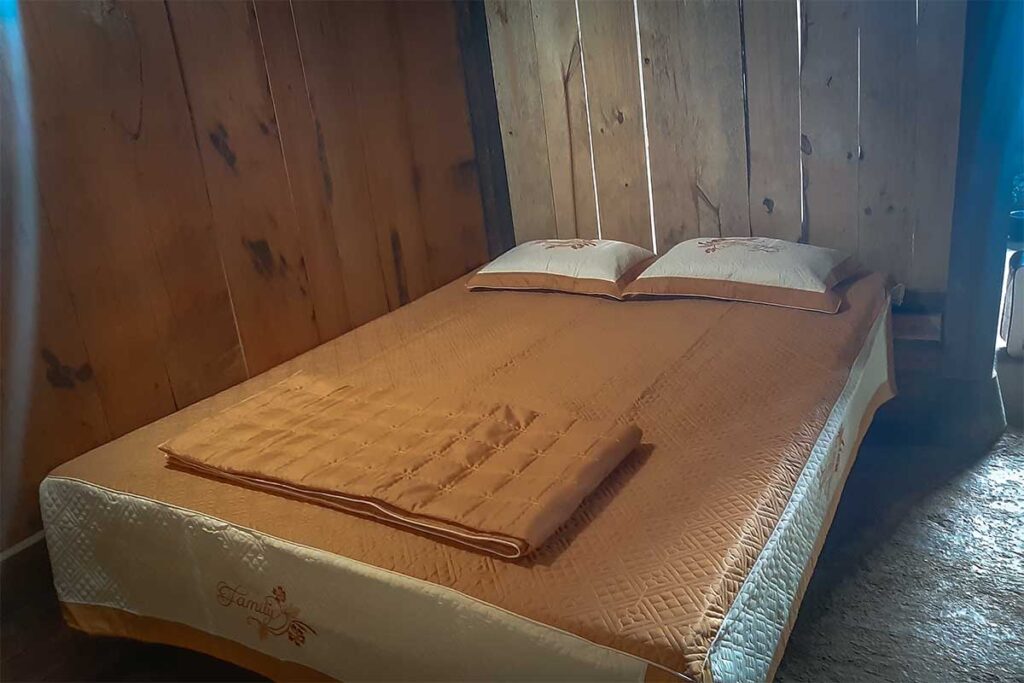
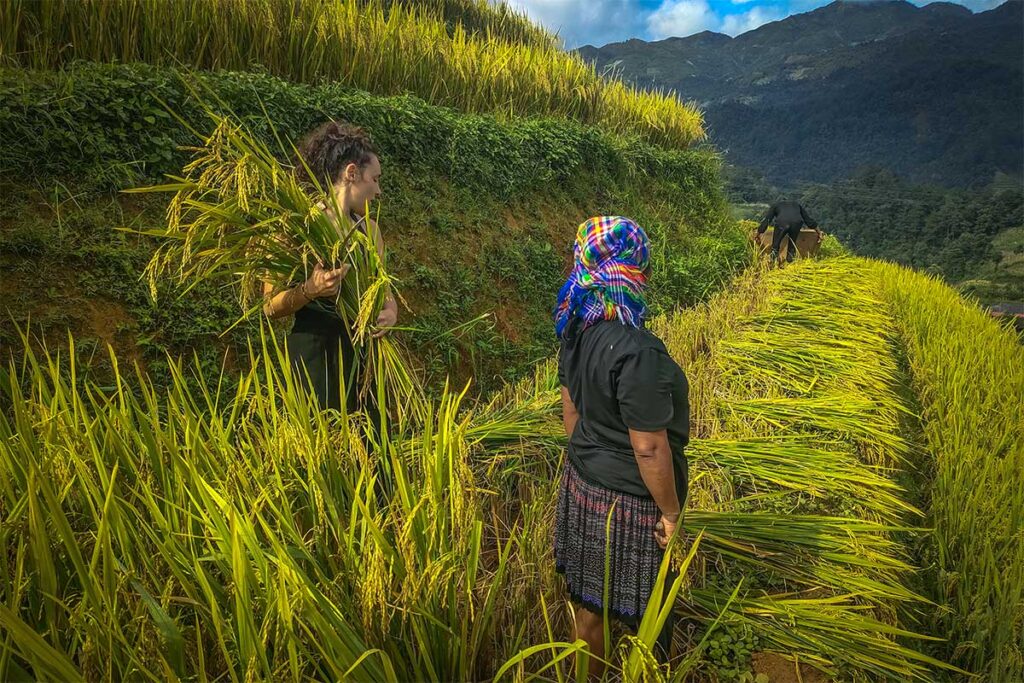
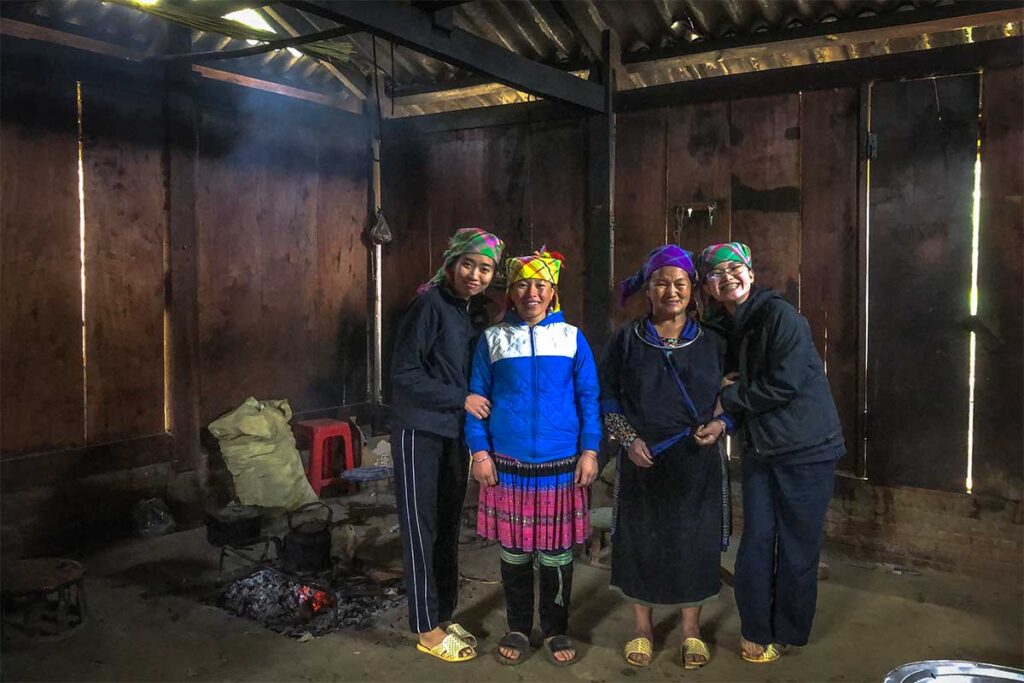
Located deep in the hills, this homestay offers an immersive cultural experience with a Hmong family. The views from the rooms are incredible, and the hospitality is genuine. Meals are shared with the family, and guests often get involved in daily life or join guided treks through nearby rice fields. Rooms are clean but simple, with very hard beds and a remote, peaceful location. Best for travelers seeking real cultural connection over comfort.
Mu Cang Homestay
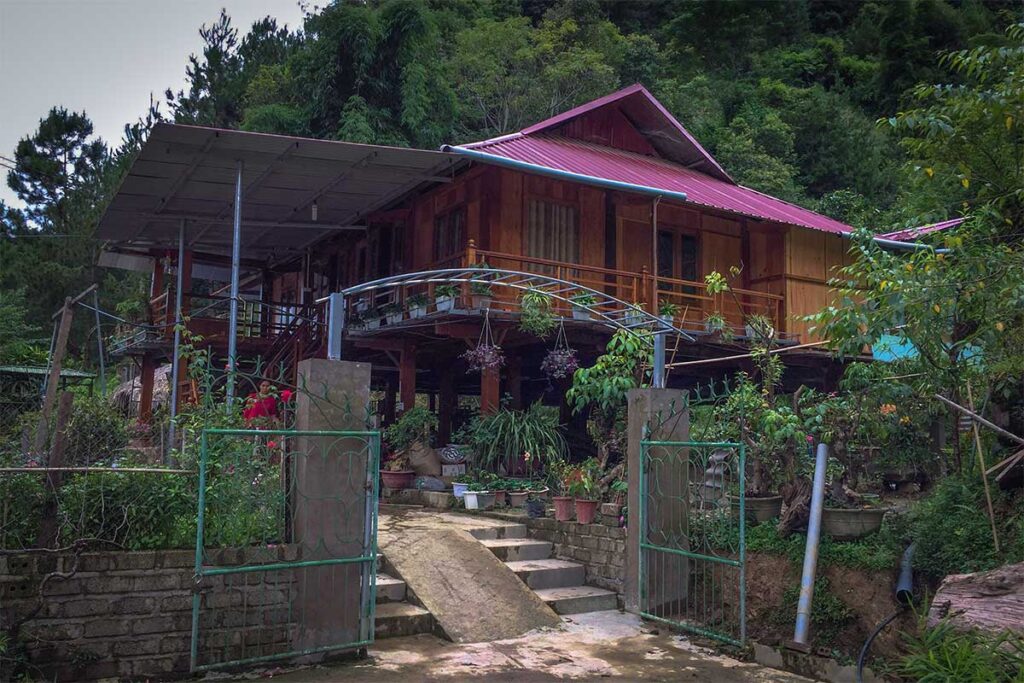
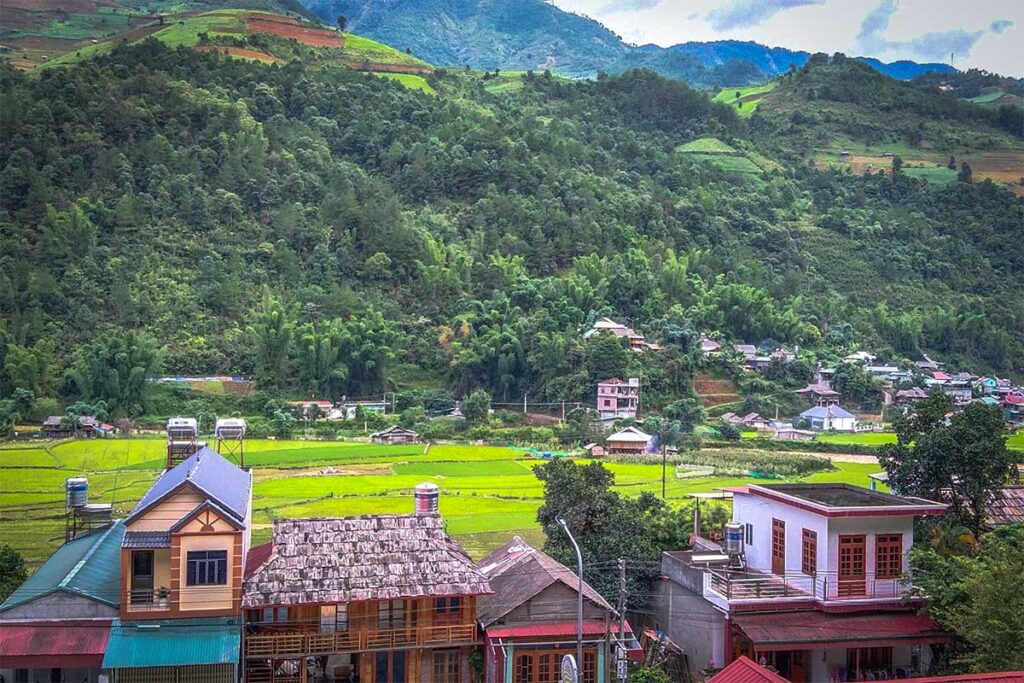
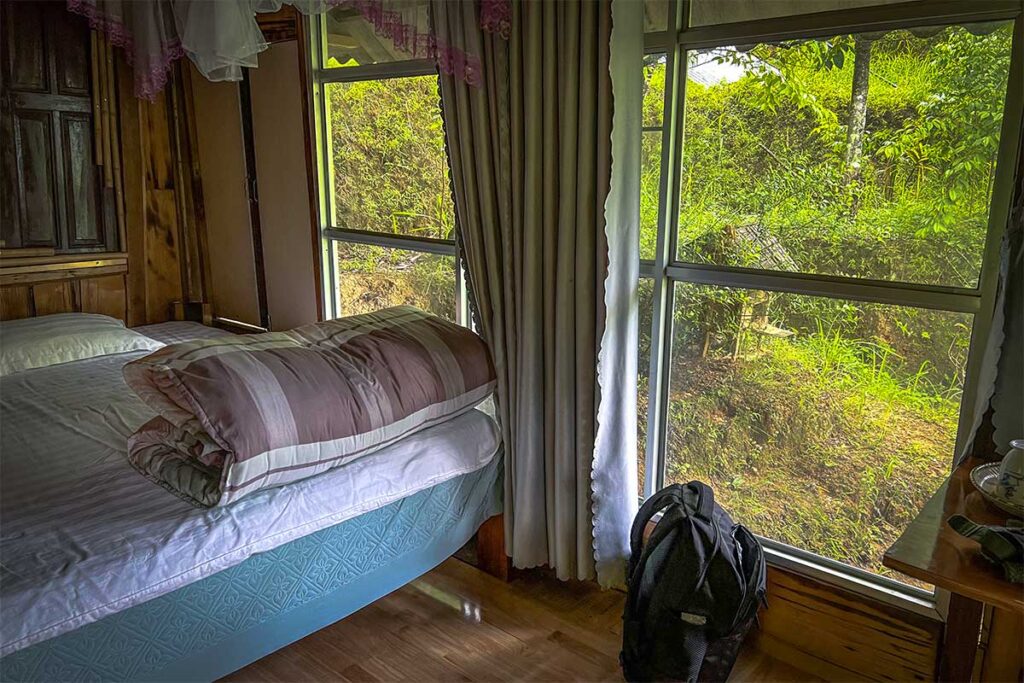
Set in a quiet location with mountain views, this homestay is known for its welcoming family and peaceful atmosphere. Rooms are clean and basic, with hot showers and comfortable beds. Motorbike rentals and local sightseeing help are readily available. While the hill leading up to the bungalows is steep, the setting makes up for it. It’s an affordable, down-to-earth place to relax and enjoy the landscape.
Hello Mu Cang Chai Homestay
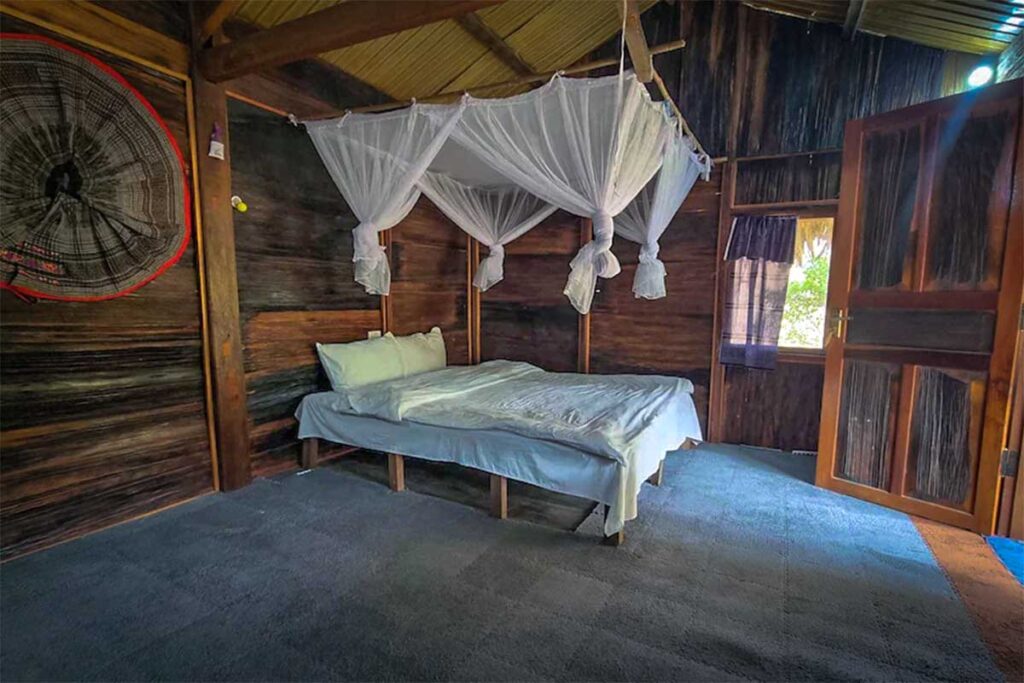
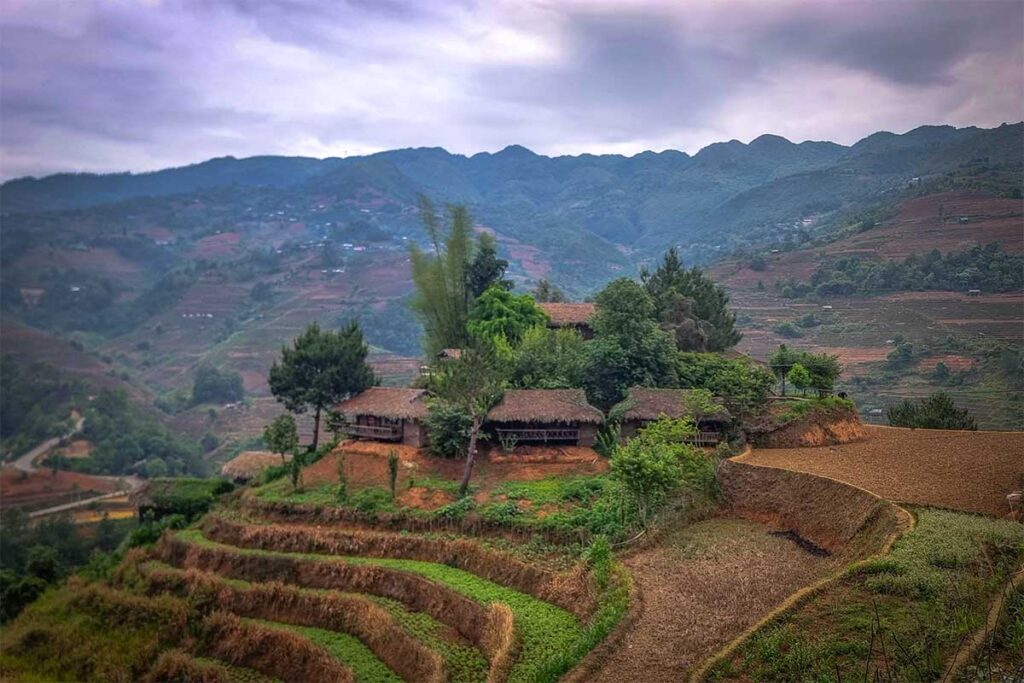
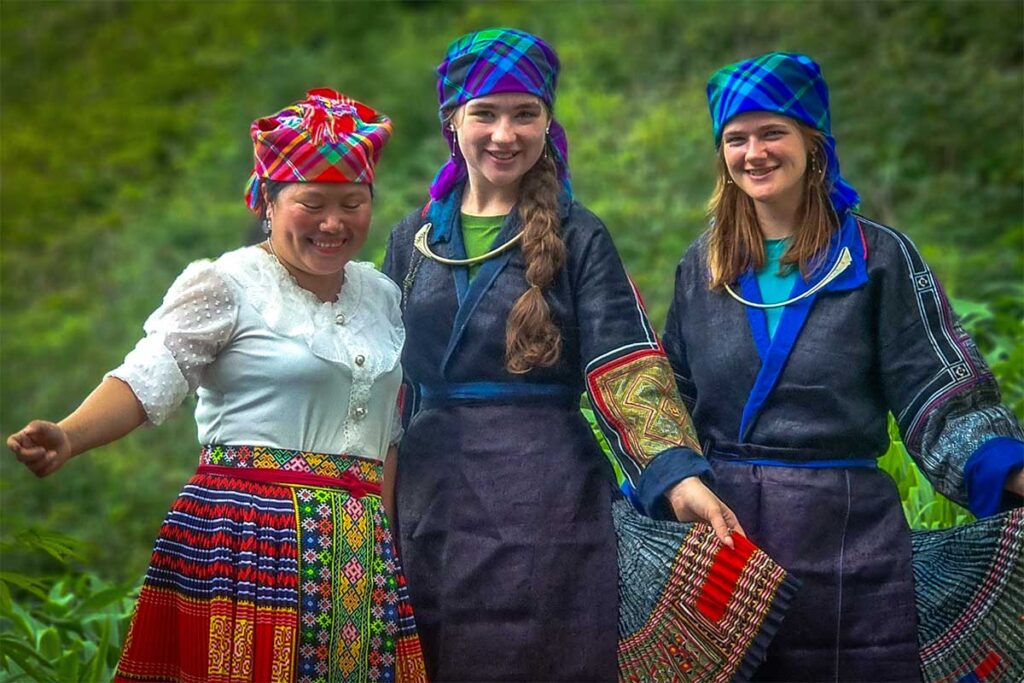
This homestay offers stunning views of the surrounding rice terraces and mountains, with a peaceful setting just outside the main town. The host, Ly, is known for her warm hospitality and excellent English, often organizing hikes, cultural activities, and family meals for guests. Rooms are simple but clean, and some have private terraces. It’s close to nature—expect insects—but mosquito nets and hot showers are provided.
Retreats and Resorts
Mu Cang Chai has slowly begun to develop more upscale lodging, though it’s far less commercialized than places like Sapa. Some retreats offer a blend of local charm with modern comforts—spacious rooms, stylish design, and extras like heated pools, spas, and curated cultural activities. These are ideal if you’re looking for comfort and scenery in one place.
Garrya Mu Cang Chai
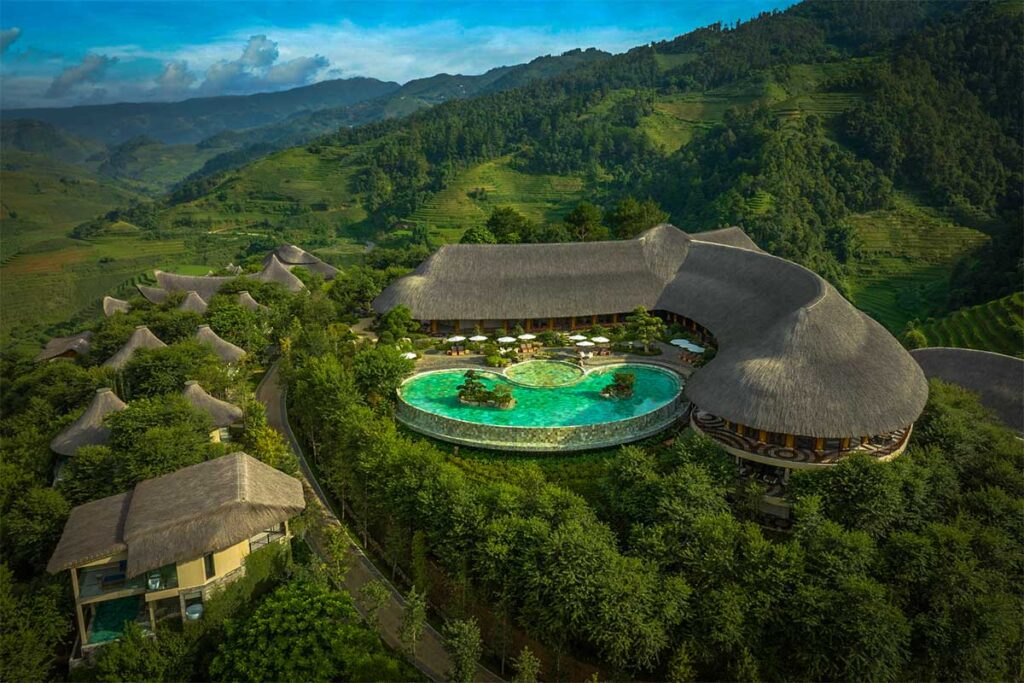
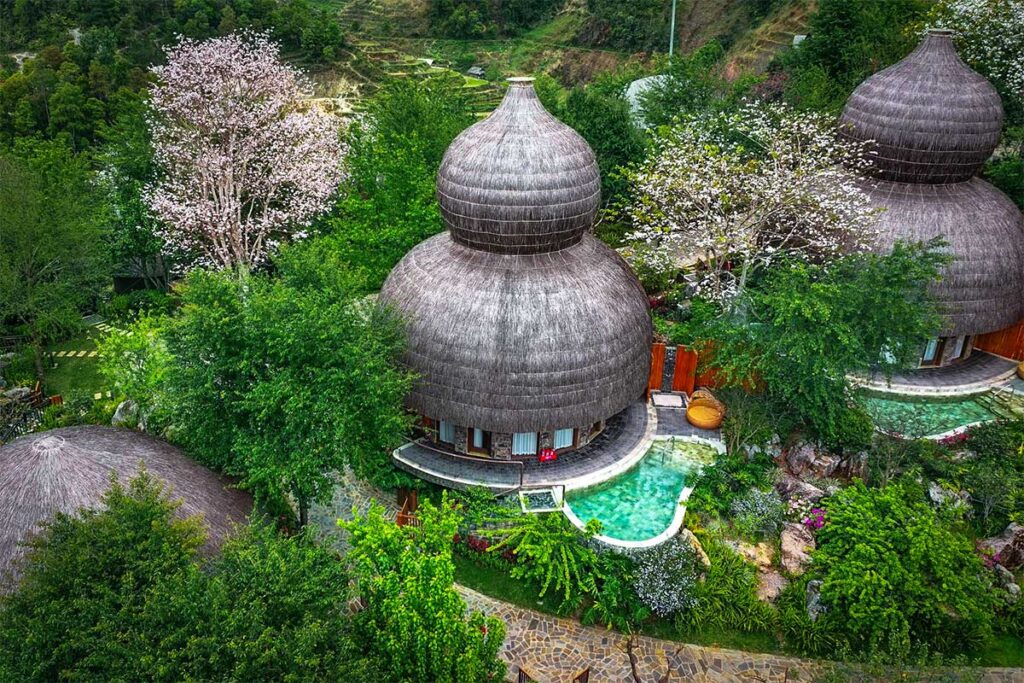
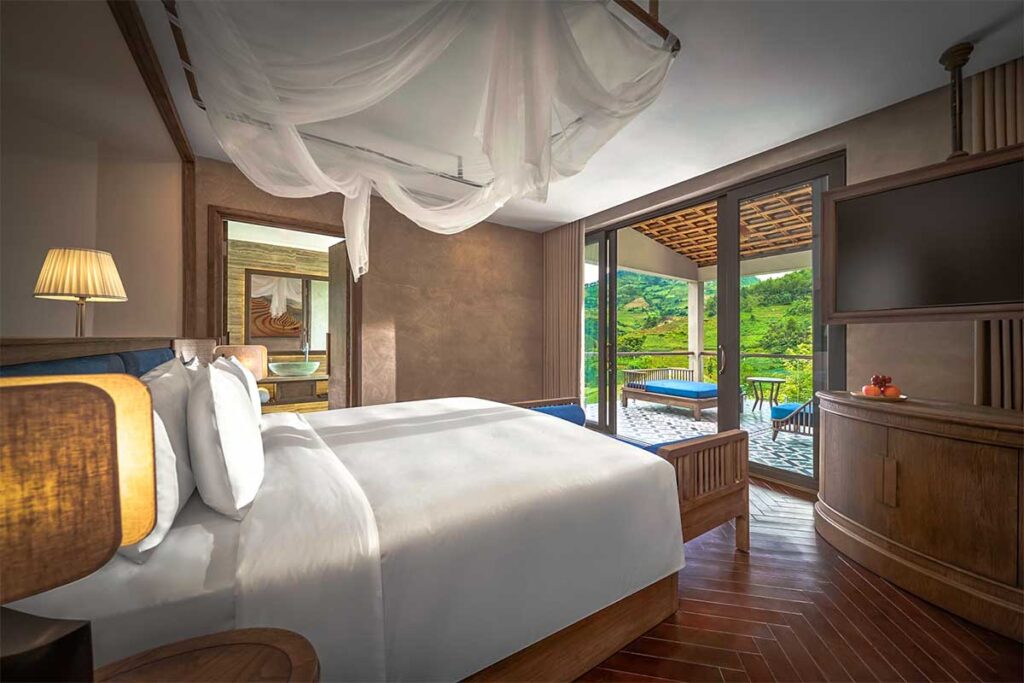
This luxury resort sits high on a ridge with sweeping 360-degree views over rice fields. Rooms are spacious, beautifully designed, and come with thoughtful amenities. There’s an infinity pool, a top-rated spa, and a gym with mountain views. The restaurant serves refined Vietnamese and international cuisine, and service is exceptional—many staff are from local communities and eager to share their traditions. It’s remote, but designed for total relaxation.
Ecolodge Mu Cang Chai
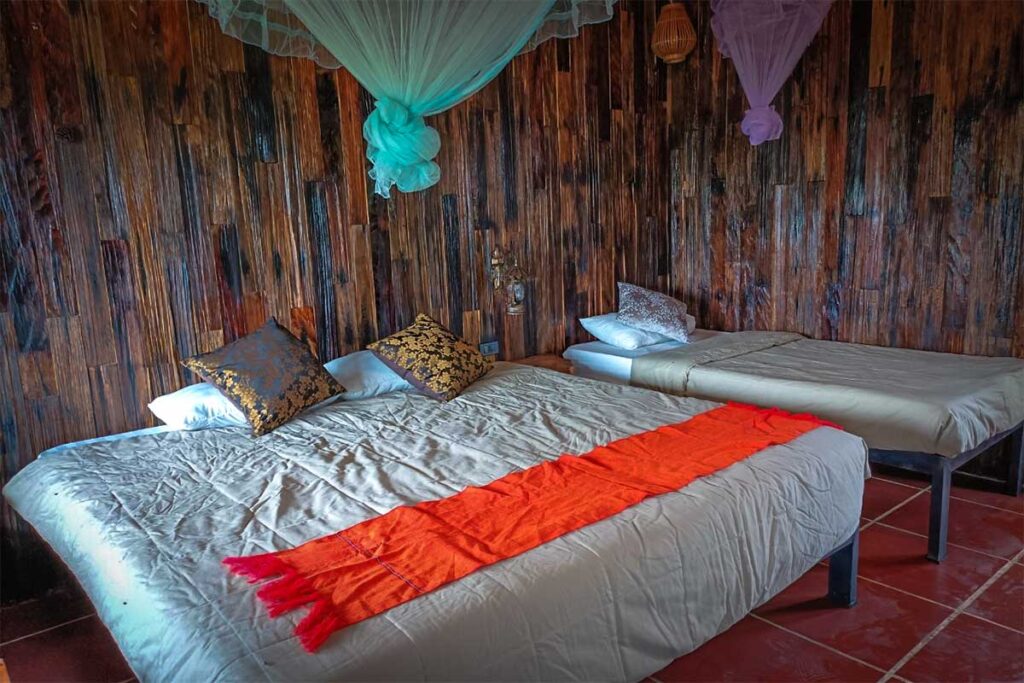
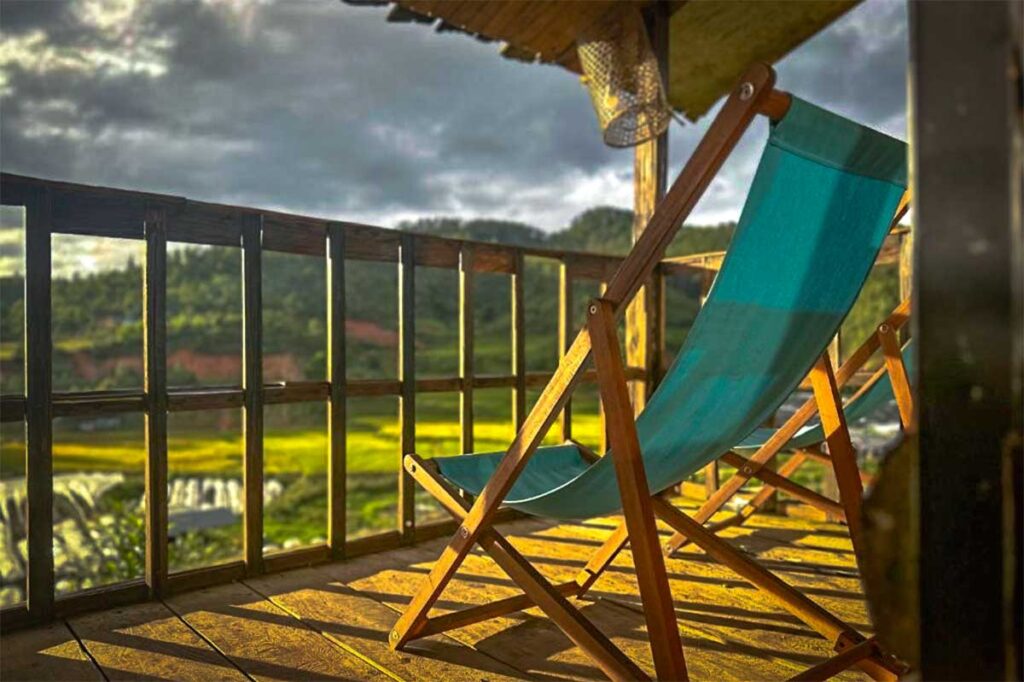
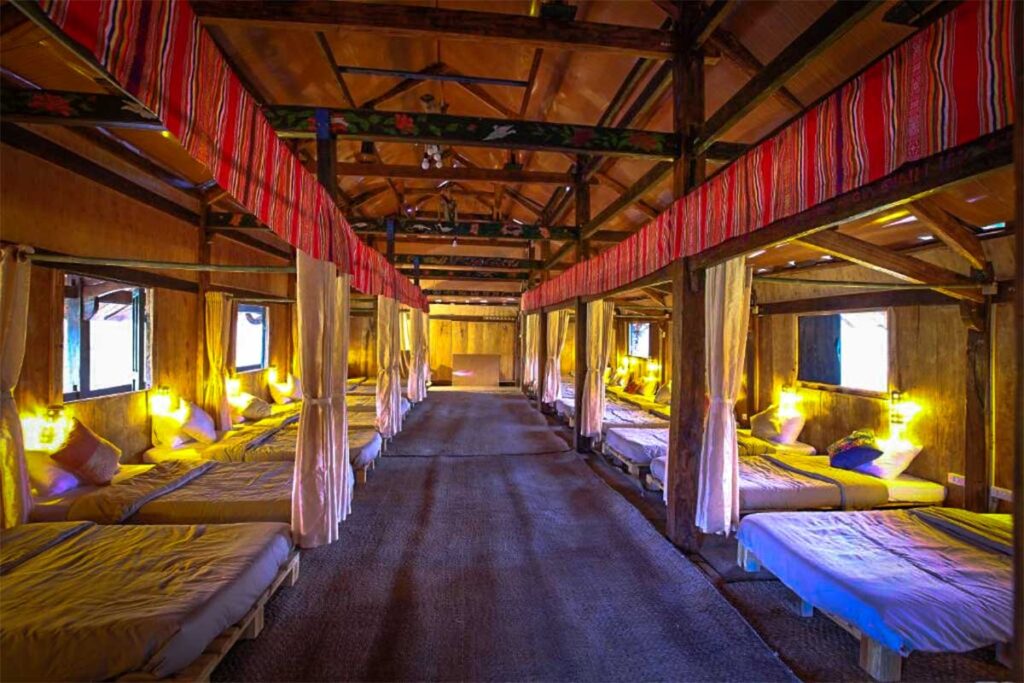
Perched in the hills at 1400 meters altitude, this lodge offers a comfortable stay with a rustic, nature-friendly atmosphere. Wooden bungalows come with private bathrooms and balconies overlooking rice terraces or flower gardens. Meals are homemade and included due to the remote setting. The staff can organize hikes, motorbike rides, and visits to nearby villages.
This is one of my new sections:
Tips for traveling to Mu Cang Chai
Bring what you need in advance
Shops in Mu Cang Chai are very limited, especially in the countryside. Before you head out, make sure to bring any essentials such as snacks, toiletries, medicine, or charging cables. Once you’re in the villages, it’s not easy to find basic supplies.
Pack for nature and weather
Insect repellent is a must, especially during the wetter months. Bring good walking shoes or hiking sandals, as paths can be uneven or muddy. Sunscreen and a hat are useful for sunny days, and a lightweight rain jacket comes in handy if the weather changes. In colder months (especially at night), warm layers are also recommended.
Bring cash from Hanoi
Although there are a couple of ATMs in Mu Cang Chai town, they may be far from your accommodation if you stay in the countryside. Many homestays, restaurants, and local shops only accept cash. It’s safest to withdraw enough Vietnamese dong while you’re still in Hanoi or another major city.
Refill your tank when you can
If you’re driving a motorbike, always top up your fuel when you pass a gas station. There is one in Mu Cang Chai town and another or two along the main road, but options are limited in smaller villages. In some remote areas, locals sell fuel from small roadside pumps, but prices may be higher and availability isn’t guaranteed.
Meals are usually at your homestay
Most travelers eat at their accommodation, especially in the countryside where restaurants are rare. In Mu Cang Chai town, there are a few simple eateries, but these mostly serve local customers. Meals at homestays tend to be generous and tasty, often shared with the host family, making them the most practical and enjoyable option.
Is Mu Cang Chai worth it?
Mu Cang Chai is absolutely worth visiting—but not for everyone. The journey is long and tiring, with no direct highway or train route. Whether you travel by car, motorbike, or bus, expect a full-day journey from Hanoi. Infrastructure is basic, and beyond the natural scenery and cultural experiences, there isn’t a long list of attractions or activities.
But for many travelers, these are exactly the reasons to go. The rice terraces are among the most beautiful in Vietnam, and the lack of development means you’re surrounded by truly local life. Tourism exists here, but it hasn’t taken over. You can stay with ethnic minority families, join authentic meals, and explore landscapes that still feel wild and untouched.
The views change with the seasons—September is the most spectacular with golden rice fields—but even outside the harvest, the terraced mountains remain stunning in form and scale. Just come with the right expectations: this is more about nature, quietness, and cultural connection than sightseeing or luxury.
Mu Cang Chai vs Sapa
Sapa is easier to reach, with express highways and a train station nearby. It’s also more developed, with a wide range of hotels, restaurants, cafes, and activities beyond trekking—like cable cars, waterfalls, and bustling markets. But all of this comes with a price: tourist crowds and commercialisation. While authentic experiences still exist in Sapa, you often need to leave the main town to find them.
Mu Cang Chai is the opposite. It’s harder to reach, but authenticity is everywhere. Small villages, quiet valleys, and local families are part of the daily scenery. It’s a place for travelers who don’t mind some effort to get off the beaten path.
Pro Tip: You don’t have to choose one. For a richer experience, consider combining both in one trip:
